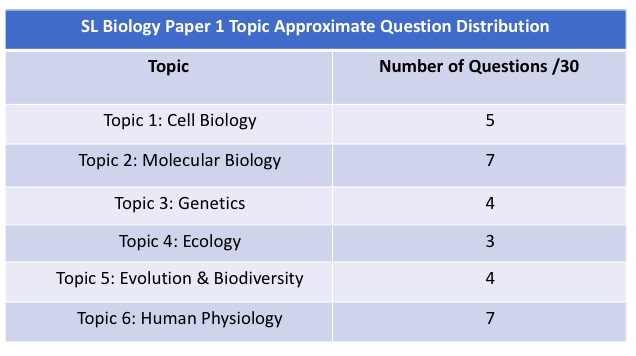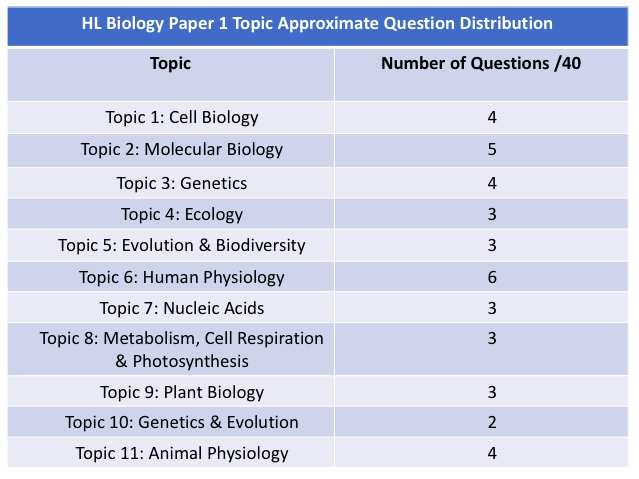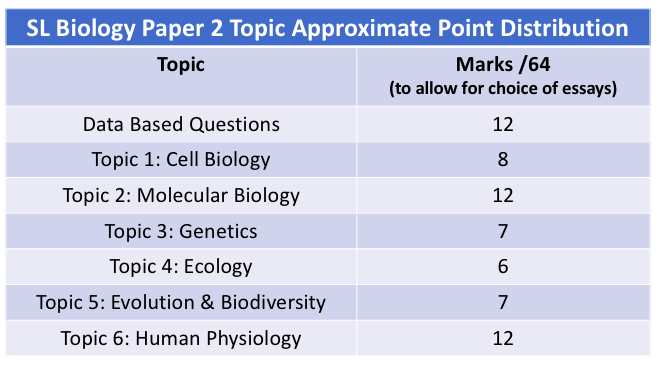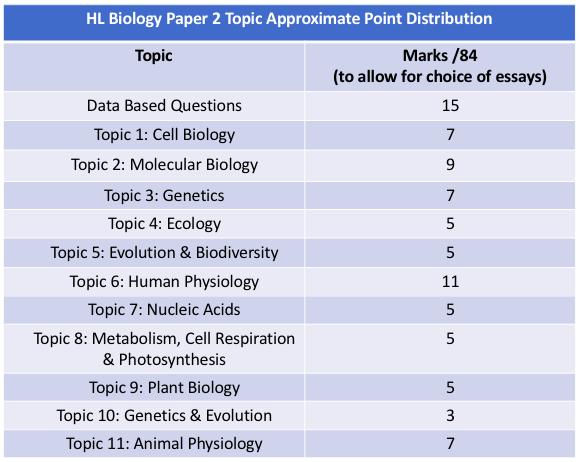IB Biology Mock Exams & Developing Exam Writing Skills
- Carly Thomas
- Jan 10, 2023
- 8 min read
Updated: Jan 14, 2024
Mock exams are happening right now at my school here in Morocco... and what a whirlwind experience they are for our Seniors. They are such an important tool in the students' preparation for the IB exams in May and if you do not do them in your school then I highly recommend you do so! It is an excellent way for students to get a feel for the format, duration and stress of IB exams in a much lower stakes situation. It is also an excellent guide for focusing future revision and determining predicted grades. In this blog post I will describe the three papers of the IB Biology exam and which skills students need for each as well as how I maximize my students learning from our Mocks.

Paper 1: Multiple Choice
The first paper of the IB Biology exam is designed to test the breadth of the content covered in the course, it is the shortest component of the IB exam, taking only 45 minutes for SL students and 1 hour for HL students. It is worth 20% of the overall IB Diploma score for both SL & HL students, the same value as the IA, but less than Paper 2. The tables below list the approximate number of questions from each topic for SL & HL students; this can be a useful tool for students and teachers as they prepare for exams.
Paper 1 questions always have four answers and are testing Objectives 1 (Knowledge & Understanding), 2 (Application) & 3 (Formulation, Analysis & Evaluation) with a ratio of 1+2:3, so Objective 3 is much more important on this Paper. Students need to demonstrate higher order thinking skills as well as memorization of facts to be successful on this paper.
The Importance of Past Papers
One of the best ways to prepare is to practice with past papers, luckily the current syllabus is quite old so there are many exams available. As long as the exam date is after May 2016 you are good to go! This usually means 3 exams are available per year, with Time Zones 1 & 2 (TZ1 & TZ2) in May and one exam in November. You can purchase these exams from the IBO directly or use software such as IB Questionbank, an excellent use of your Science budget in my opinion. If your school has been an IB school for a while you should have paper copies of old exams around, the IBO always sends some extras every year just in case and you get to keep them!
Multiple Choice Exam Writing Skills
It is always a good idea to spend some time with your students going through different strategies for each of the papers. Here are some of my favourite tips I give students for Paper 1 questions:
Write in the question booklet, the IBO only checks your answer sheet!
Eliminate answers whenever you can, cross them out right on the paper
Circle or underline key words, this is especially important for Objective 3 questions
When in doubt go with your gut, only change your first answer if you are 100% sure
Skip hard questions on the first go through, put a star beside them and come back later
Pay careful attention to any included diagrams, they are there for a reason!
Paper 2: Data Analysis & Connecting Topics
Paper two is the most important paper of the IB Biology exam, it is worth 40% of the students grade in SL Biology & 36% of the grade in HL Biology. This is also the longest paper of the exam, it is 1 hour and 15 minutes in length for SL students and 2 hours and 15 minutes in length for HL students. When preparing your students for this paper it is wise to divide it into three sections:
Section A (34 marks SL & 40 marks HL) includes:
Question 1 a data-based questions (12 marks SL & 15 - 18 marks HL)
Remaining questions are short answer, structured questions which often connect multiple subtopics and may include drawings or calculations
Section B (16 marks SL & 32 marks HL)
Students always have a choice in Section B
SL students much choose one from two groups of questions, each group containing three questions, one of which is worth 7 or 8 marks
HL students much choose two from three groups of questions, each group containing three questions, one of which is worth 7 or 8 marks
Each group of questions is worth 15 points with an additional point for the quality of the writing, if an examiner only has to read your response once then you will most likely get than extra point!
Data Analysis Skills:
The very first question of Section A is a single, long question which includes a large number of graphs and diagrams for students to interpret. These questions usually connect to several different course topics, although they focus much more on analysis and evaluation skills than knowledge and understanding. In preparing for this question it is good to spend some time with students reviewing how to interpret different types of graphs, the importance of slowing down and really examining the axes, the key, the title and any background information provided. Oftentimes the answers to these questions require that students slow down and really read with care. It is also very important to include units and quantities in answers whenever possible.
I highly recommend incorporating these types of Past Paper questions into your course assessments and review tools, although perhaps more in Year 2 once students are more familiar with the majority of the course content.
Essay Question Skills:
Section B includes short answer questions which the IBO calls "essays". One of the first things that students will need to do is choose which questions they want to tackle. Each cluster of questions is worth the same point total - 15 points per question group.You may recall that SL need only choose one cluster while HL students need to choose two. Students should keep in mind the number of points they are confident that they can earn when making their choice... if they are unsure about the 7 or 8 point question then they need to be very confident about the other two questions (usually worth 3 - 5 points each).
Once students make their choice they should take a minute to brainstorm the components of their answer, they can even write a short outline (to be crossed out later) to help them keep their ideas organized. It is always a good idea to be sure to define any key terms in the question as this is often a point in the markscheme. For any biological processes students should write in a sequential manner, being sure to describe each step with precision and using the correct vocabulary. Students can often get points for annotated diagrams in these questions as well, although they must be relevant to the question.
Paper 3: Laboratory Skills & Options
The final paper of the IB Biology exam is designed to test students knowledge of the required skills and laboratory Practicals in Section A (usually 3 questions) and then the chosen Option in Section B (usually 4 or 5 short answer questions per option). Students need only complete one of the four option sections, based on which option they studied. Paper 3 is middling in length, it is allocated 1 hour for SL students and 1 hour and 15 minutes for HL students. It is worth 24% of HL students final score and 20% for SL students.
Unfortunately, this paper is often neglected by both students and teachers as it focuses on Options and lab skills rather than the entirety of the course. It is equal in value for SL students and for HL students it is worth 4% more than both the IA & Paper 1, so be smart and prepare well for it! Like every paper of this exam using past papers and grading your answers with the markschemes is excellent practice.
The Importance of Command Terms
Command terms are the verbs used to declare which skill the IBO wants students to demonstrate with a particular question. The complete list can be found on pages 166 & 167 of the IB Biology subject guide or in the document below. Students often struggle to gain the points in the markscheme simply because they did not follow the command term correctly. For this reason a couple of years into teaching IBDP Biology I started allowing students to use the command term glossary during test and quizzes in Year 1. This allows them to practice interpreting Paper 2 and 3 questions correctly and gradually learn all of the command terms. I simply printed and laminated the document below and pull it out for tests, quizzes and practice questions. This allows students to familiarize themselves with the command terms over multiple exposures and understand how to use them with real IB questions.
Once it's time for your exam review, for both Mocks and the real deal in May (or November) then I recommend taking some time to do some activities in class. I suggest you look at how they are broken down into each Objective and remind your students that Objective 3 is the most important one for all three papers! One fun activity and brain break is to post a paper in 3 corners of your classroom, one for "Objective 1", "Objective 2" and "Objective 3" and then reading out a command term and having students move to the objective where they think it belongs.
There are also free Quizlets online that you can have students use to practice, here is a good one. As you may know I am a big fan of sort activities, they get students using their hands and collaborating as they sort terms, images &/or concepts. Here is a fun sort activity you can do to see if students really remember those command terms. If you incorporate practice of the command terms into your course I am certain that your students' will improve on the IB exam!
I have also put together a few more Command Term Activities including a domino loop game and a crossword puzzle. I have found that it is critical to review Command Terms regularly and often throughout the course, I am for at least once a semester, so a variety of activities are necessary to keep students engaged.
Making your Mock Exam
Making a mock exam can be a time consuming task for teachers. In order to ensure that it follows the correct ratio of questions per topic you have a few choices... you can build it from scratch using the question ratios included in the tables earlier in this post. You can also choose one IB exam and give it to your students to complete, you will need to make sure that there are no missing diagrams (sometimes copyrighted images are removed after the exam) and that you have covered all of the content in the course. The last option is to combine two exams, so that any questions you have to remove (because you haven't covered it yet or there is a missing diagram) can easily be taken from the other exam. I used to do this with a pair of scissors and a glue stick, but now my school has IB Questionbank, which makes everything much easier. Whichever format you choose, try to ensure that the exam mimics a real IB exam as closely as possible to ensure your students get good practice.
My Mock Exam Feedback Form
After the exam is over I grade them using the IB markschemes and then fill out this form for my students and their parents. This helps them to understand the trends in their performance and guides their revision. I like to scan these reports for my own files as I make predicted grades and track my students performance on the IB exam.
I hope that this post was helpful and for those who are making, grading or writing IB exams: good luck!
Thanks for reading teachers, travelers & curious souls of all kinds.
The Roaming Scientist









